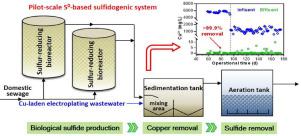Water Research ( IF 11.4 ) Pub Date : 2021-03-03 , DOI: 10.1016/j.watres.2021.116999 Guibiao Li , Zhensheng. Liang , Jianliang Sun , Yanying Qiu , Chuyin Qiu , Xiaomin Liang , Yuhang Zhu , Peng Wang , Yu Li , Feng Jiang

|
Elemental sulfur (S0) reduction process has been demonstrated as an attractive and cost-efficient approach for metal-laden wastewater treatment in lab-scale studies. However, the system performance and stability have not been evaluated in pilot- or large-scale wastewater treatment. Especially, the sulfide production rate and microbial community structure may significantly vary from lab-scale system to pilot- or large-scale systems using real domestic sewage as carbon source, which brings questions to this novel technology. In this study, therefore, a pilot-scale sulfur-based sulfidogenic treatment system was newly developed and applied for the treatment of Cu-laden electroplating wastewaters using domestic sewage as carbon source. During the 175-d operation, >99.9% of Cu2+ (i.e., 5580 and 1187 mg Cu/L for two types of electroplating wastewaters) was efficiently removed by the biogenic hydrogen sulfide that produced through S0 reduction. Relatively high level of sulfide production (200 mg S/L) can be achieved by utilizing organics in raw domestic sewage, which was easily affected by the organic content and pH value of the domestic sewage. The long-term feeding of domestic sewage significantly re-shaped the microbial community in sulfur-reducing bioreactors. Compared to the reported lab-scale bioreactors, higher microbial community diversity was found in our pilot-scale bioreactors. The presence of hydrolytic, fermentative and sulfur-reducing bacteria was the critical factor for system stability. Accordingly, a two-step ecological interaction among fermentative and sulfur-reducing bacteria was newly proposed for sulfide production: biodegradable particulate organic carbon (BPOC) was firstly degraded to dissolved organic carbon (DOC) by the hydrolytic and fermentative bacteria. Then, sulfur-reducing bacteria utilized the total DOC (both DOC degraded from BPOC and the original DOC present in domestic sewage) as electron donor and reduced the S0 to sulfide. Afterwards, the sulfide precipitated Cu2+ in the post sedimentation tank. Compared with other reported technologies, the sulfur-based treatment system remarkable reduced the total chemical cost by 87.5‒99.6% for the same level of Cu2+ removal. Therefore, this pilot-scale study demonstrated that S0 reduction process can be a sustainable technology to generate sulfide for the co-treatment of Cu-laden electroplating wastewater and domestic sewage, achieving higher Cu2+removal and higher cost-effectiveness than the conventional technologies.
中文翻译:

中试规模的基于硫的硫化物中试系统,以实际生活污水为电子给体,用于处理含铜电镀废水
在实验室规模的研究中,元素硫(S 0)还原工艺已被证明是一种用于处理含金属废水的有吸引力且具有成本效益的方法。但是,尚未在中试或大规模废水处理中评估系统性能和稳定性。尤其是,从实验室规模的系统到使用实际生活污水作为碳源的中试或大型系统,硫化物的生产率和微生物群落结构都可能有很大的不同,这给这项新技术带来了疑问。因此,在本研究中,新开发了中试规模的基于硫的硫化物处理系统,并将其用于以生活污水为碳源的含铜电镀废水的处理。在175-d操作期间,> 99.9%的Cu 2+(通过两种S 0产生的生物硫化氢)有效去除了铜(对于两种类型的电镀废水,分别为5580和1187 mg Cu / L)。减少。通过在生活污水中利用有机物可以实现相对较高的硫化物产量(200 mg S / L),这很容易受到生活污水中有机物含量和pH值的影响。长期供给生活污水可显着改变还原硫生物反应器中的微生物群落。与报告的实验室规模的生物反应器相比,在我们的中试规模的生物反应器中发现了更高的微生物群落多样性。水解,发酵和还原硫细菌的存在是系统稳定性的关键因素。因此,新提出了发酵菌和还原硫菌之间的两步生态相互作用,用于生产硫化物:可生物降解的颗粒有机碳(BPOC)首先被水解和发酵细菌降解为溶解的有机碳(DOC)。然后,还原硫细菌利用总DOC(从BPOC降解的DOC和生活污水中存在的原始DOC)作为电子给体,并还原了S。0至硫化物。之后,硫化物在后沉淀池中沉淀出Cu 2+。与其他已报道的技术相比,基于硫的处理系统在相同水平的Cu 2+去除率下,可将总化学成本显着降低87.5%至99.6%。因此,该中试研究表明,S 0还原工艺可以作为一种可持续的技术来产生硫化物,用于含铜电镀废水和生活污水的协同处理,与传统方法相比,可实现更高的Cu 2+去除率和更高的成本效益。技术。









































 京公网安备 11010802027423号
京公网安备 11010802027423号